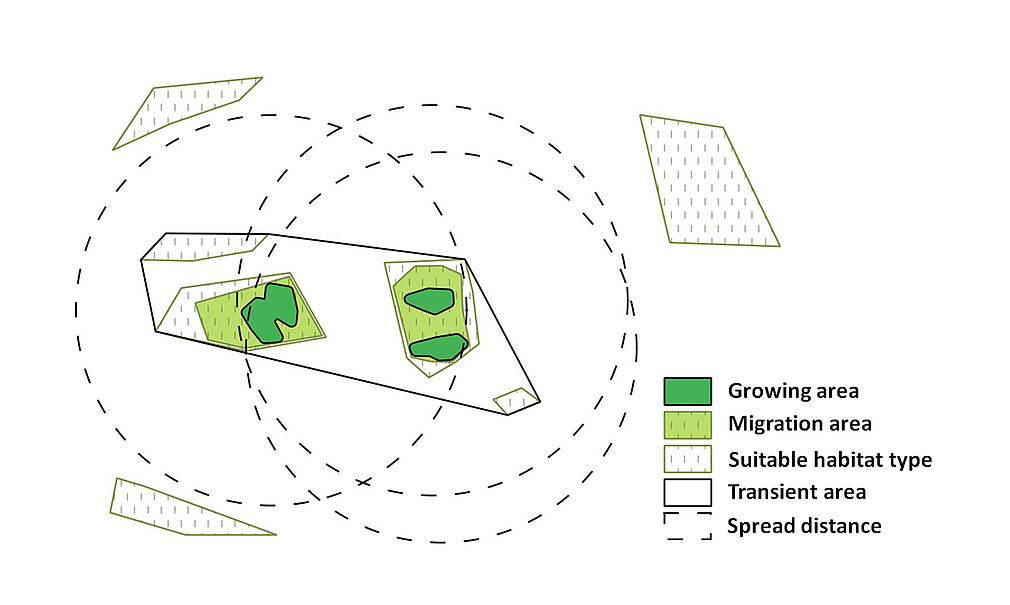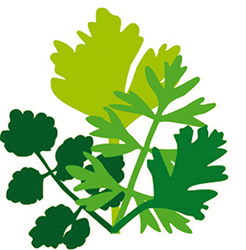Why and how is Germany committed to the protection of wild plants for food and agriculture?
- By signing the International Seed Convention and the Convention on Biological Diversity, Germany has committed itself to preserving wild plants for food and agriculture in situ, i.e. at their place of occurrence. The Federal Ministry of Food and Agriculture (BMEL) has included this as a need for action in the National Programme for Plant Genetic Resources and is currently working on establishing a network of genetic reserves in Germany.
- The conservation of species diversity and their potential for use is an important social objective. Nature conservation and agriculture therefore work together to conserve these genetic resources.
Why was wild celery chosen for a genetic conservation network?
The wild celery was selected on the basis of a combination of criteria that made it an excellent model object. This included the presence of four wild species in Germany. They are the wild relatives of celeriac, which we know e.g. as tuber celery or leaf celery and use, for example, in soup greens or as spices. In principle, wild plants can contain heritable traits that are not present in the related cultivated plant species. They are an indispensable resource for breeding in order to adapt crops to changing production conditions and to secure our food supply.
Furthermore, the distribution areas of the four wild celery species extend throughout Germany, so that special features specific to the federal states were taken into account in the establishment of genetic reserves. These species are endangered throughout Germany. Among them is a highly endangered one, i.e. Helosciadium repens. Sufficient information on the biology of the taxa are available for planning and implementation of species-specific maintenance measures. In addition, initial experience has been gained from measures to reintroduce and increase the population size of H. repens.
What is a "genetic reserve"?

A genetic reserve is an area designated for the management and monitoring of the genetic diversity of a plant species in its natural habitat. The occurrences selected for genetic reserves altogether represent the intra-specific diversity of the species and together form the network of genetic reserves.
Model of a genetic reserve: An area contains the growth areas of the target species, the migration areas and the transitional area. In the growing area, ideal growing conditions should be created or maintained for the target occurrence. The migration area is formed by the sites adjacent to the growth area, which are suitable for colonisation by the target species, so that the occurrence can increase or shift due to changes in growth conditions. Ideally, the migration area will be maintained or used in a way that allows colonisation by the species. The growth and migration areas are surrounded by a transition area. It is formed by all types of biotopes potentially suitable for colonisation by the target species within the propagation distance of the target occurrence and the areas in between. Ideally, the maintenance or use of the transitional areas should be carried out in such a way that migration of the target species, in particular the transport of diaspores, is not prevented.
Why is it necessary to establish these areas? Are these not also covered by nature conservation?
In the case of genetic reserves, the focus lies on the safeguarding of plant genetic resources for breeding research and facilitating access to these resources. For this reason, the conservation status of the target species populations should be monitored and seeds collected. The seeds are stored in a gene bank and can be retrieved from it according to the internationally valid rules for research and development. In a genetic reserve, in situ conservation is systematically combined with ex situ conservation.
Genetic reserves are established primarily for wild plants for food and agriculture. This also includes endangered species that are not already in the focus of species protection, such as Helosciadium nodiflorum. Especially for occurrences of these species, the establishment of genetic reserves represents an added value.
A prerequisite for the conservation of genetic resources is the preservation of intra-specific diversity, i.e. the diversity of gene variants and genotypes that are relevant for the characteristic expressions within a species and for its adaptability to environmental conditions. Due to scarcity of resources, practical nature conservation focuses on the conservation of ecosystem and species diversity - but not on the intra-specific diversity.
Do the establishments of genetic reserves have legal consequences for the use of such areas?
Genetic reserves do not constitute a legal category of protected areas in Germany. They are based on voluntary cooperation between a central scientific institution (the coordination unit) and local stakeholder (e.g. land owners, nature conservation authorities and associations). If an adaptation of use or appropriate maintenance measures should be necessary for the conservation of the population, the coordination unit clarifies together with the local actors whether implementation is possible. There is no obligation under any circumstances.
How are the wild celery species in Germany?
The wild celery species in Germany are Apium graveolens (wild celery), Helosciadium inundatum, H. nodiflorum and H. repens. All in all, the four wild celery species in Germany are endangered, as there are only rather small and too few populations.
The species occur in moist to wet habitats, are in need of light and weak in competition. The occurrences usually only exist because natural disturbances (e.g. beaten paths of wild animals) or e.g. grazing pushes back the more competitive species. In many wild celery populations, however, such effects are not sufficient, so that the populations remain very small and could even go extinct. Presence checks in 2015 confirmed a large number of known occurrences. This did not apply to H. inundatum, which occurs predominantly in small ponds in northwestern Germany. This species could only be found in about half of the original habitats. One possible reason for this is that small waters sometimes overgrow because they are no longer maintained and accumulate nutrients.
Are there any cross-connections to the ex situ conservation of wild celery?
Small quantities of seed are to be collected from each occurrence and stored in the Gene Bank for Wild Plants for Food and Agriculture (Genbank WEL). These are backup copies of the genetic composition of the populations at the time of collection. Part of the seed samples should also be usable, e.g. for reintroduction or breeding research. The gene bank facilitates access to genetic resources for users without endangering wild populations.
Why is in situ conservation needed alongside ex situ conservation?
In order to conserve ecosystems efficiently in the long term, the intra-specific diversity must be protected. Species will be able to respond to environmental changes (e.g. longer droughts due to climate change) through genetic adaptation only if there is sufficient diversity. The conservation of the entire intra-specific diversity ex situ is not feasible as it would be too resource-intensive. Therefore, the focus lies on in situ conservation. The "genetic reserve conservation technique" combines ex situ conservation with the complementary in situ conservation: on the one hand, a static pattern of intra-specific diversity is safeguarded in the gene bank; on the other hand, in situ conservation allows for the continuous adaptation of reproductive populations to changing habitat conditions. In situ conservation is thus, in contrast to ex situ conservation, dynamically oriented.
Could the wild celery species in any way play a breeding role in the future?
In Germany celery is grown on a relatively small area of approximately 2,000 ha. Its consumption is rather low with approximately 1 kg per capita. Nevertheless, the sales revenues of the producer markets amount to almost € 10 million annually. The interest of breeding research relates above all to existing disease resistances. Another interest is to reduce the allergen potential of celeriac. Celery has to be declared in food due to a highly effective allergen. The search for allergen-free or low allergen populations or individuals can be interesting for breeders.
A further option for the future could be to use the non-domesticated wild species not only as genetic resources for celeriac, but also to cultivate these species themselves if they have properties that will prove beneficial for agriculture or consumers.
